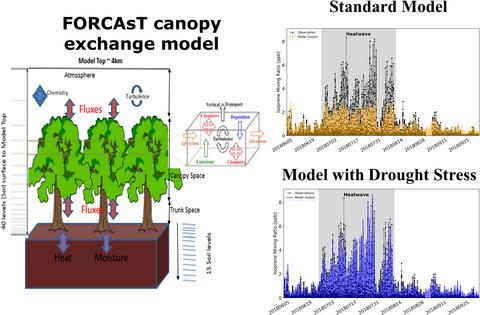当前位置:
X-MOL 学术
›
Glob. Change Biol.
›
论文详情
Our official English website, www.x-mol.net, welcomes your feedback! (Note: you will need to create a separate account there.)
Modelling the effect of the 2018 summer heatwave and drought on isoprene emissions in a UK woodland.
Global Change Biology ( IF 11.6 ) Pub Date : 2019-12-13 , DOI: 10.1111/gcb.14963 Frederick Otu-Larbi 1 , Conor G Bolas 2 , Valerio Ferracci 3 , Zosia Staniaszek 2 , Roderic L Jones 2 , Yadvinder Malhi 4 , Neil R P Harris 3 , Oliver Wild 1 , Kirsti Ashworth 1
Global Change Biology ( IF 11.6 ) Pub Date : 2019-12-13 , DOI: 10.1111/gcb.14963 Frederick Otu-Larbi 1 , Conor G Bolas 2 , Valerio Ferracci 3 , Zosia Staniaszek 2 , Roderic L Jones 2 , Yadvinder Malhi 4 , Neil R P Harris 3 , Oliver Wild 1 , Kirsti Ashworth 1
Affiliation

|
Projected future climatic extremes such as heatwaves and droughts are expected to have major impacts on emissions and concentrations of biogenic volatile organic compounds (bVOCs) with potential implications for air quality, climate and human health. While the effects of changing temperature and photosynthetically active radiation (PAR) on the synthesis and emission of isoprene, the most abundant of these bVOCs, are well known, the role of other environmental factors such as soil moisture stress are not fully understood and are therefore poorly represented in land surface models. As part of the Wytham Isoprene iDirac Oak Tree Measurements campaign, continuous measurements of isoprene mixing ratio were made throughout the summer of 2018 in Wytham Woods, a mixed deciduous woodland in southern England. During this time, the United Kingdom experienced a prolonged heatwave and drought, and isoprene mixing ratios were observed to increase by more than 400% at Wytham Woods under these conditions. We applied the state-of-the-art FORest Canopy-Atmosphere Transfer canopy exchange model to investigate the processes leading to these elevated concentrations. We found that although current isoprene emissions algorithms reproduced observed mixing ratios in the canopy before and after the heatwave, the model underestimated observations by ~40% during the heatwave-drought period implying that models may substantially underestimate the release of isoprene to the atmosphere in future cases of mild or moderate drought. Stress-induced emissions of isoprene based on leaf temperature and soil water content (SWC) were incorporated into current emissions algorithms leading to significant improvements in model output. A combination of SWC, leaf temperature and rewetting emission bursts provided the best model-measurement fit with a 50% improvement compared to the baseline model. Our results highlight the need for more long-term ecosystem-scale observations to enable improved model representation of atmosphere-biosphere interactions in a changing global climate.
中文翻译:

模拟 2018 年夏季热浪和干旱对英国林地异戊二烯排放的影响。
预测的未来极端气候事件,如热浪和干旱,预计将对生物挥发性有机化合物 (bVOC) 的排放和浓度产生重大影响,并可能对空气质量、气候和人类健康产生影响。虽然温度变化和光合有效辐射 (PAR) 对异戊二烯(这些 bVOC 中最丰富的物质)的合成和排放的影响是众所周知的,但土壤水分胁迫等其他环境因素的作用尚未完全了解,因此在陆地表面模型中表现不佳。作为 Wytham 异戊二烯 iDirac 橡树测量活动的一部分,整个 2018 年夏季在英格兰南部的混合落叶林地 Wytham Woods 进行了异戊二烯混合比的连续测量。在这段时间,英国经历了长时间的热浪和干旱,在这些条件下,观察到 Wytham Woods 的异戊二烯混合比增加了 400% 以上。我们应用最先进的 FOREst Canopy-Atmosphere Transfer 冠层交换模型来研究导致这些浓度升高的过程。我们发现,尽管目前的异戊二烯排放算法重现了热浪前后冠层中观察到的混合比,但该模型在热浪干旱期间低估了约 40% 的观察结果,这意味着模型可能会大大低估未来异戊二烯向大气中的释放轻度或中度干旱的情况。基于叶片温度和土壤含水量 (SWC) 的应激诱导的异戊二烯排放被纳入当前的排放算法,从而显着改善模型输出。SWC、叶片温度和再润湿排放爆发的组合提供了最佳的模型测量拟合,与基线模型相比提高了 50%。我们的结果强调需要更长期的生态系统尺度观测,以改进全球气候变化中大气-生物圈相互作用的模型表示。
更新日期:2020-01-23
中文翻译:

模拟 2018 年夏季热浪和干旱对英国林地异戊二烯排放的影响。
预测的未来极端气候事件,如热浪和干旱,预计将对生物挥发性有机化合物 (bVOC) 的排放和浓度产生重大影响,并可能对空气质量、气候和人类健康产生影响。虽然温度变化和光合有效辐射 (PAR) 对异戊二烯(这些 bVOC 中最丰富的物质)的合成和排放的影响是众所周知的,但土壤水分胁迫等其他环境因素的作用尚未完全了解,因此在陆地表面模型中表现不佳。作为 Wytham 异戊二烯 iDirac 橡树测量活动的一部分,整个 2018 年夏季在英格兰南部的混合落叶林地 Wytham Woods 进行了异戊二烯混合比的连续测量。在这段时间,英国经历了长时间的热浪和干旱,在这些条件下,观察到 Wytham Woods 的异戊二烯混合比增加了 400% 以上。我们应用最先进的 FOREst Canopy-Atmosphere Transfer 冠层交换模型来研究导致这些浓度升高的过程。我们发现,尽管目前的异戊二烯排放算法重现了热浪前后冠层中观察到的混合比,但该模型在热浪干旱期间低估了约 40% 的观察结果,这意味着模型可能会大大低估未来异戊二烯向大气中的释放轻度或中度干旱的情况。基于叶片温度和土壤含水量 (SWC) 的应激诱导的异戊二烯排放被纳入当前的排放算法,从而显着改善模型输出。SWC、叶片温度和再润湿排放爆发的组合提供了最佳的模型测量拟合,与基线模型相比提高了 50%。我们的结果强调需要更长期的生态系统尺度观测,以改进全球气候变化中大气-生物圈相互作用的模型表示。



























 京公网安备 11010802027423号
京公网安备 11010802027423号